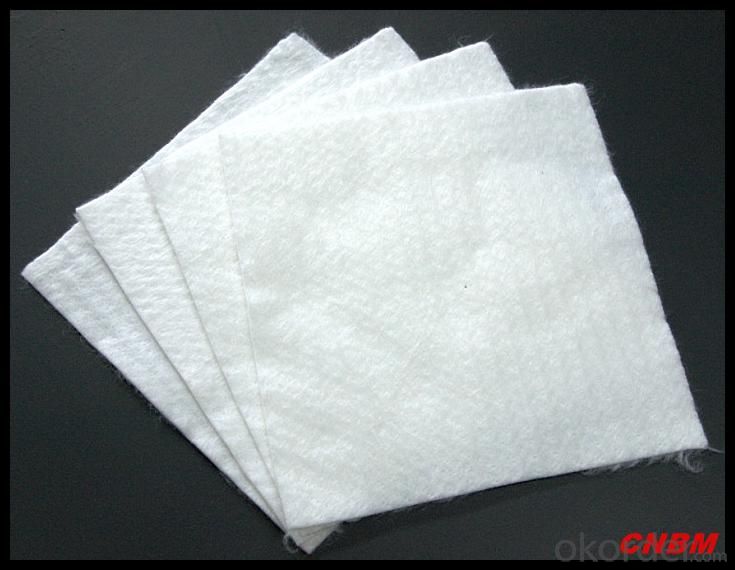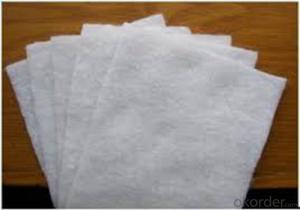Polypropylene Nonwoven Geotextile for Construction Continuous Filament
- Loading Port:
- China main port
- Payment Terms:
- TT or LC
- Min Order Qty:
- 1000 m²
- Supply Capability:
- 300000 m²/month
OKorder Service Pledge
OKorder Financial Service
You Might Also Like
Item specifice
1. Geotextile Description
Polyester Continuous Filament Spunbonded non woven geotextile
Geotextiles are permeable nonwoven fabrics used to separate,filter,reinforce, protect or drain.Geotextiles allow filtration or separation of granular layers in roads and rail applications,used to protect membranes in landfill applications,used in coastal defence applications and used in landscaping to protect surfaces and structures from weeds and root growth.

2. Packaging & Shipping
Packing: Woven bag
Shipping: About 15 days after receipt the deposit.
3. Specification
Weight: 80gsm-120gsm
Width: 1m-6m
Length: as required;
Color: White, Black, As required
4. FAQ:
Q: What kind of payments does jenor support?
A: T/T, L/C, Cash are accepted.
Q: Do you charge for the samples?
A: Accordeing to our company policy, the samples are free, we only charge the freight fee. And we will return the freight fee during the next order.
Q: Can you produce according to customers' design?
A: Sure, we are professional manufacturer, OEM and ODM are both welcome.
- Q:How do geotextiles contribute to the sustainability of construction projects?
- Geotextiles contribute to the sustainability of construction projects in several ways. Firstly, they can act as a barrier to prevent soil erosion, which helps to protect the surrounding environment and maintain the integrity of the construction site. Secondly, geotextiles can enhance the stability and longevity of structures by providing reinforcement and improving soil mechanics. This reduces the need for excessive use of materials and resources, making construction projects more sustainable. Additionally, geotextiles can aid in the conservation of water resources by promoting proper drainage and preventing waterlogging. Overall, the use of geotextiles in construction projects helps to minimize environmental impacts while improving the efficiency and durability of structures, contributing to long-term sustainability.
- Q:Filter geotextile performance ~ main function ~
- Filter geotextile performance ~ main function ~
- Q:Geotextile laying should be beyond the edge of how to set the number of specific requirements? Which specification is more detailed
- Can be more than 1 meter or so, I am specializing in the production of geotechnical materials, wish smooth
- Q:On the road where the laying of geotextiles should be how to shop
- Like roadbed fill, fill the junction and so on can be shop, a layer of a layer of shop, fixed good.
- Q:Geotextile how to sample
- It is best in the middle of a piece of cloth cut 1 square meters on the line
- Q:How are geotextiles tested for durability?
- Geotextiles are tested for durability through various methods, including exposure to environmental factors such as sunlight, moisture, and temperature changes. Additionally, they undergo mechanical tests like puncture resistance, tear strength, and tensile strength evaluations. These tests help determine the geotextile's ability to withstand long-term use and maintain its structural integrity in different applications.
- Q:What are the key factors affecting the puncture resistance of geotextiles?
- The key factors affecting the puncture resistance of geotextiles include the material composition, thickness, and density of the geotextile, as well as the shape, size, and velocity of the puncturing object. Other factors such as the installation method, environmental conditions, and the presence of any protective layers also play a role in determining the puncture resistance of geotextiles.
- Q:How do geotextiles affect soil nutrient availability?
- Geotextiles can have both positive and negative effects on soil nutrient availability. On one hand, they can help retain nutrients in the soil by preventing erosion and leaching, thus promoting their availability for plant uptake. On the other hand, geotextiles can also impede nutrient penetration into the soil, potentially reducing their availability for plants. The specific impact of geotextiles on soil nutrient availability depends on factors such as the type of geotextile, its installation method, and the specific nutrient in question.
- Q:What are the different geotextile installation techniques for steep slopes?
- There are several geotextile installation techniques that can be used for steep slopes. Some of the common techniques include slope stabilization with geotextile mats or grids, slope reinforcement with geotextile wraps or anchors, and soil erosion control with geotextile blankets or erosion control mats. Each technique is chosen based on the specific requirements of the slope and the desired outcome.
- Q:How do geotextiles contribute to soil filtration?
- Geotextiles contribute to soil filtration by acting as a barrier that allows water to pass through while preventing the movement of soil particles. They help to retain sediment, filter out pollutants, and improve water quality, ultimately enhancing the overall filtration and drainage capabilities of the soil.
1. Manufacturer Overview |
|
|---|---|
| Location | |
| Year Established | |
| Annual Output Value | |
| Main Markets | |
| Company Certifications | |
2. Manufacturer Certificates |
|
|---|---|
| a) Certification Name | |
| Range | |
| Reference | |
| Validity Period | |
3. Manufacturer Capability |
|
|---|---|
| a)Trade Capacity | |
| Nearest Port | |
| Export Percentage | |
| No.of Employees in Trade Department | |
| Language Spoken: | |
| b)Factory Information | |
| Factory Size: | |
| No. of Production Lines | |
| Contract Manufacturing | |
| Product Price Range | |
Send your message to us
Polypropylene Nonwoven Geotextile for Construction Continuous Filament
- Loading Port:
- China main port
- Payment Terms:
- TT or LC
- Min Order Qty:
- 1000 m²
- Supply Capability:
- 300000 m²/month
OKorder Service Pledge
OKorder Financial Service
Similar products
New products
Hot products
Related keywords

































